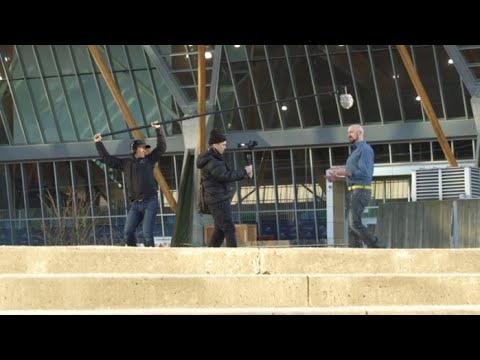Career Overview
People in this occupation play a support role in the production of motion pictures, broadcasting, photography and the performing arts.
People in these careers work for:
- Television and radio stations
- Television and radio networks
- Recording studios
- Motion picture and video production companies
- Theatre and stage companies
This occupational group includes projectionists who work for IMAX or automated cinemas and drive-in theatres.
Job Titles
Duties
Camera crane operators:
- Set up, assemble, adjust, maintain and replace reels and projector equipment
- Detect and repair mechanical and electrical problems
- Change and install an electronic control panel using automated equipment
Motion picture projectionists:
- Check the condition of the copy
- Set up and load film reels on movie and drive-in theatre projection systems
- Adjust focus, sound levels and other projector and theatre settings
- Maintain projection equipment
Props persons and set builders:
- Assemble, repair, place, build and oversee props
Script assistants:
- Distribute scripts to actors
- Keep detailed notes of all actions, positions and camera angles
- Photograph and date scenes
Grips and riggers:
- Rig, place, move and dismantle sets, backdrops, scenery and other stage equipment
Dressers:
- Clean, maintain, transport and store costumes
- Help performers to dress in costumes
Production assistants:
- Provide support to the director and producer
- Are responsible for various aspects of production such as preparing schedules
- Set up equipment
- Make travel arrangements to various shooting locations
Earnings
Earnings is income that workers receive in exchange for their labour. Depending on the type of employment, earnings can be in the form of wages (hourly), salaries (fixed monthly or annual) or self-employed earnings.
Work Environment
# Workers Employed
3,740% Employed Full Time
14%Key aspects of the work in this occupation:
- Work takes place both indoors and outdoors in varied weather conditions
- Workers may be exposed to electrical circuitry, high tension wires, transformers or other equipment that could be a source electrical shock
- Workers may use equipment, machinery or power tools that could be a source of injury
Career Pathways
Progression to related technical occupations in motion pictures, broadcasting or the performing arts is possible with additional training or experience.
There may be an overlap in duties among occupations in this unit group, depending on the size of the production or broadcasting studio.
Occupational Interests
It’s important to understand what kinds of occupations align with your interests.
For more about occupational interests visit Skills for the Future Workforce > Characteristics.
Here are the top occupational interest(s) for this career profile:
Education, Training and Skills
- Completion of secondary school is usually required.
- Most occupations in this unit group require completion of college courses in broadcasting, theatre arts or a related field
or
A period of on-the-job training - Certification for projectionists is available, but voluntary, in New Brunswick. In Quebec, projectionists are regulated under operators of electrical machines, cinema equipment
- Projectionists are required to be licensed by their province of employment
Workers who are certified for an occupation by a regulator elsewhere in Canada can apply for the same certification from the regulator in B.C. Under the terms of the Canadian Free Trade Agreement (CFTA), most applicants who are transferring their credentials from elsewhere in Canada will not be required to complete additional training or testing. However, the B.C. regulator may ask applicants to provide further information such as a letter of good standing, references, or criminal record check.
For those who trained outside of Canada and never received certification from any Canadian jurisdiction, a full assessment is likely needed. Most occupational regulators have a process for assessment and recognize internationally trained applicants.
For information about labour mobility in Canada, visit www.workersmobility.ca.
View a list of Professional Regulatory Authorities in B.C.
Education programs in B.C.

Top Skills
Every job calls for a certain set of skills. Knowing those skills is the first step in finding a good career fit.
Here, you will find the 10 most relevant workplace skills. Some are more important to achieving success in a certain career than others. These skills may come naturally to you or you may need to gain them through education, training and experience.
See the list of work-related skills below, ranked in order of importance for this career. Check out the list and see if this career matches your skills—take that first step!
Giving full attention to what other people are saying, taking time to understand the points being made, asking questions as appropriate, and not interrupting at inappropriate times.
Keeping track of and assessing your performance, other individuals, or organizations to make improvements or take corrective action.
Adjusting actions in relation to others' actions.
Talking to others to share information effectively.
Understanding written sentences and paragraphs in work-related documents.
Using logic and reasoning to identify the strengths and weaknesses of alternative solutions, conclusions or approaches to problems.
Being aware of others’ reactions and understanding why they react as they do.
Managing one’s own time and the time of others.
Considering the relative costs and benefits of potential actions to choose the most appropriate one.
Controlling operations of equipment or systems.
Labour Market Statistics
Discover data, facts and information that have been gathered and analyzed. Learn about the characteristics of the economy and labour market in B.C.
Employment
Find out about employment types and trends by region and industry.
Employment
3,740Employment by Region







| Region | Employment | % Employment of this Occupation |
|---|---|---|
| Cariboo | 0 | 0.0% |
| Kootenay | 0 | 0.0% |
| Mainland/Southwest | 3,410 | 91.2% |
| North Coast and Nechako | 10 | 0.3% |
| Northeast | 0 | 0.0% |
| Thompson-Okanagan | 135 | 3.6% |
| Vancouver Island/Coast | 170 | 4.5% |
Labour Market Outlook
The B.C. Labour Market Outlook is a 10-year forecast of the expected supply and demand for labour in the province. It’s usually updated every year. The purpose is to provide British Columbians with the knowledge to make informed decisions on careers, skills training, education and hiring.
Forecasted Job Openings (2025-2035)
1,590Forecasted Job Openings
Forecasted Employment Growth Rate
Composition of Job Openings
Job Openings by Region (2025-2035)







| Region | Job Openings | Avg. Annual Employment Growth |
|---|---|---|
| Cariboo | Not available | Not available |
| Kootenay | Not available | Not available |
| Mainland/Southwest | 1,420 | 1.4% |
| North Coast and Nechako | Not available | Not available |
| Northeast | Not available | Not available |
| Thompson-Okanagan | 50 | 1.8% |
| Vancouver Island/Coast | 120 | 2.5% |
Industry Highlights
Learn about the opportunities in B.C.'s major industries, including employment trends, earning potential, locations of work and more.
Forecasted Job Openings by Industry
| Industry | Job Openings (2025-2035) |
|---|---|
| Information, Culture and Recreation | 1,380 |
| Professional, Scientific and Technical Services | 90 |
| Repair, Personal and Non-Profit Services | 30 |
| Construction | 30 |
| Retail Trade | 10 |
Resources
-
Academy of Canadian Cinema and Television (ACCT)www.academy.ca
-
Canadian Film Centre (CFC)www.cfccreates.com
-
Canadian Media Producers Association (CMPA)www.cmpa.ca
-
CineVic Society of Independent Filmmakerswww.cinevic.ca
-
Cineworks Independent Filmmakers Societywww.cineworks.ca
-
Creative Women Workshops Association (CWWA) and Women in the Director’s Chair (WIDC)www.widc.ca
-
Documentary Organization of Canada – BC Chapter (DOC BC)docbcytnt.org
-
Emily Carr University of Art + Designwww.ecuad.ca
-
Motion Picture Production Industry Association of BC. (MPPIA)mppia.com
-
Praxis Centre for Screenwriterswww.praxisfilm.com
-
The Association of Canadian Film Craftspeople (ACFC) Westwww.acfcwest.com
-
Vancouver Film School – Job Boardmyvfs.com/jobboard
-
Victoria Independent Film Professionals Association (VIFPA)www.vifpa.com








